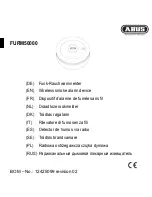
Page - 4
Page - 17
The Window Unit With Status Light & Valet Switch
Valet
Switch
Status
Light
•
The Valet Switch is used in the procedure of programming operational
features and also for encoding transmitters to the system. A complete
description of the Valet Switch and its operations is on page 8.
The Blue Status Lights report the operational status
of the system at all times, and also serves as a visual
deterrent to break-ins and theft. Specific description
of the Status Light operation may be found on pages
9-10.
The Valet Switch has three main functions:
•
The Valet Switch can be used to turn off the
remote engine starting functions of the system placing
it in “Remote Start Valet Mode”.
•
The Valet Switch can also be used, in conjunction
with the vehicle’s ignition key, to perform an emergency
override when the system is in a “locked” state. This
is used in the event the transmitter is lost or becomes
inoperable. This is referred to as “performing an
Emergency Override”.
One of the components, typically mounted on the windshield, is the
Window Unit module which contains the Status Lights and the Valet
Switch. The window unit also receives communications from the system’s
remote transmitters.
The
Transmitter & Basic Functions
“
start
” button
“
trunk
” button
“
lock
”
button
“
unlock
”
button
Transmitter part numbers:
147-03 buttonsw/ text, chrome finish
147-03B buttons w/ icons, black chrome finish
Transmitter battery replacement:
Remove the small screw from the
lower back case, and separate the
transmitter case halves. Replace the
CR2032 (or 2 CR2016 batteries) coin-
type battery and reassemble the transmitter.
Feature #5 Extended Starter Cranking Time
Factory Default Setting:
Minimum (.7 Second)
(
press
“lock” button to program
)
Options:
Medium Lo (1.25 Second)
(
press
“unlock” button to program
)
Medium Hi (1.75 Second)
(
press
“trunk” button to program
)
Maximum (2.5 Second)
(
press
“start” button to program
)
Extended Starter Cranking Time operates in conjunction with the feature #2’s
“Tachless” setting. When the system is set for “Tachless”, this feature sets the
duration of the starter output for the 1st start attempt. If the engine doesn’t start on
the first attempt, the system will retry up to 3 more times. With each attempt, the
output will be extended by 0.2 seconds. There are four different base starter output
settings. While the default-set minimum is sufficient for most vehicles; the
Extended Starter Cranking Time can be used for difficult-to-start engines. This
feature should only be programmed by the installer.
This feature changes the operation of the Green wire (negative) on the satellite relay
port. This gives you the flexibility to accomodate certain vehicles that require any
out-of-the-ordinary pulses or remote start timing.
•
The first setting operates as a secondary START output. This will have the same
pulse timing as the large Violet wire on the main harness.
•
The second setting will give a 0.8 second pulse immediately after the large
Violet wire’s output stops.
•
The third setting will give a 0.8 second pulse immediately after the remote start
shuts down by any means.
•
The fourth setting operates as a secondary ACCESSORY output. This will have
the same operation as the large Orange wire on the main harness. This fea-
ture should only be programmed by the installer.
Feature #6 Doorlocking Functions
Factory Default Setting:
0.8 Second Lock & Unlock Output
(
press
“lock” button to program
)
Options:
3 Second Lock & Unlock Output
(
press
“unlock” button to program
)
Double Pulse Unlock Output
(
press
“trunk” button to program
)
Total Closure Lock Output
(
press
“start” button to program
)
This single feature gives the installer several needed options, to match the RS-310-
EDP’s doorlocking outputs to suit different vehicle requirements.
•
The first setting (programmed by the “lock” button) has the system
produce both the lock and unlock outputs as 0.8 second in duration. This is the
most common form of output needed, which interfaces most vehicles.




























